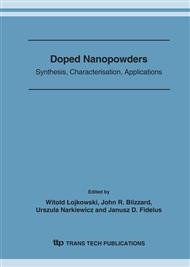p.173
p.179
p.187
p.193
p.199
p.207
p.213
p.219
p.225
Spectroscopic and Magnetic Properties of Gadolinium Macroacyclic and Macrobicyclic Complexes
Abstract:
As a result of the Schiff base condensation the gadolinium macroacyclic and macrobicyclic Schiff base complexes have been synthesized and investigated by infrared spectroscopy (IR) and electron paramagnetic resonance (EPR). Both electron ionization and electron spray Molecular Spectroscopy spectra confirmed the [1:1] proportion of a ligand to metal in gadolinium macrocyclic and mocrobicyclic Schiff base complex samples. The thermogravimetrydifferential thermal analysis (TG-DTA) indicated the presence of two water molecules in the innersphere of the macrobicyclic complex and confirmed no water coordination of the metal ion in the macroacyclic complex. The temperature dependence of the integrated intensity of the EPR spectra enabled the magnetic interactions in the spin system of these compounds to be revealed.
Info:
Periodical:
Pages:
199-205
Citation:
Online since:
October 2007
Keywords:
Price:
Сopyright:
© 2007 Trans Tech Publications Ltd. All Rights Reserved
Share:
Citation:


